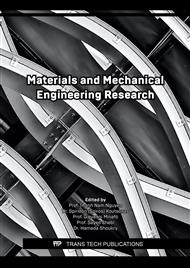[1]
A.J. McEvily, I Le May, Hydrogen-assisted cracking,, Materials Characterization 26 (1991) 253-268.
DOI: 10.1016/1044-5803(91)90016-w
Google Scholar
[2]
C.B. Beachem, A new model for hydrogen-assisted cracking (hydrogen "embrittlement"),, Metallurgical and Materials Transactions B 3 (1972) 441-455.
DOI: 10.1007/bf02642048
Google Scholar
[3]
H.P. Van Leeuwen, A quantitative model of hydrogen induced grain boundary cracking,, Corrosion 29 (1973) 197–204.
DOI: 10.5006/0010-9312-29.5.197
Google Scholar
[4]
R.A. Oriani, P.H. Josephic, Equilibrium and kinetic studies of the hydrogen-assisted cracking of steel,, Acta Metalurgica 25 (1977) 979-988.
DOI: 10.1016/0001-6160(77)90126-2
Google Scholar
[5]
C.L. Briant, Hydrogen assisted cracking of type 304 stainless steel,, Metallurgical Transactions A 10 (1979) 181–189.
DOI: 10.1007/bf02817627
Google Scholar
[6]
W.W. Gerberich, T. Livne, X.F. Chen, M. Kaczorowski, Crack growth from internal hydrogen—temperature and microstructural effects in 4340 steel,, Metallurgical Transactions A 19 (1988) 1319-1334.
DOI: 10.1007/bf02662593
Google Scholar
[7]
C.J. McMahon Jr., Hydrogen-induced intergranular fracture of steels,, Engineering Fracture Mechanics 68 (2001) 773-788.
DOI: 10.1016/s0013-7944(00)00124-7
Google Scholar
[8]
D. Symons, A comparison of internal hydrogen embrittlement and hydrogen environment embrittlement of X-750,, Engineering Fracture Mechanics 68 (2001) 751-771.
DOI: 10.1016/s0013-7944(00)00123-5
Google Scholar
[9]
R.L.S. Thomas, J.R. Scully, R.P. Gangloff, Internal hydrogen embrittlement of ultrahigh-strength AERMET 100 steel,, Mallurgical and Materials Transactions A 34 (2003) 327-344.
DOI: 10.1007/s11661-003-0334-3
Google Scholar
[10]
Y. Lee, R.P. Gangloff, Measurement and modeling of hydrogen environment–assisted cracking of ultra-high-strength steel,, Metallurgical and Materials Transactions A 38 (2007) 2174-2190.
DOI: 10.1007/s11661-006-9051-z
Google Scholar
[11]
B. Meng, C. Gu, L. Zhang, C. Zhou, X. Li, Y. Zhao, J. Zheng, X. Chen, Y. Han, Hydrogen effects on X80 pipeline steel in high-pressure natural gas/hydrogen mixtures,, International Journal of Hydrogen Energy 42 (2017) 7404-7412.
DOI: 10.1016/j.ijhydene.2016.05.145
Google Scholar
[12]
R.P. Gangloff, Comprehensive structural integrity-environmentally assisted failure,, Elsevier Ltd, Oxford, United Kingdom, 2003, pp.1-101.
Google Scholar
[13]
M.H. EI Haddad, T.H. Topper, K.N. Smith, Prediction of non propagating cracks,, Engineering Fracture Mechanics 11 (1979) 573-584.
DOI: 10.1016/0013-7944(79)90081-x
Google Scholar
[14]
H. Kitagawa, S. Takahashi, Applicability of fracture mechanics to very small cracks or the cracks in the early stage,, In: Proc. 2nd Intern. Conf. Mech. Behav. Mater., Boston, ASM, Cleveland, Ohio, 1976, p.627–631.
Google Scholar
[15]
A. Tange, T. Akutu, N. Takamura, Relation between shot-peening residual stress distribution and fatigue crack propagation life in spring steel,, Transactions of JSSE, 1991(36) (1991) 47-53.
DOI: 10.5346/trbane.1991.47
Google Scholar
[16]
K. Ando, R. Fueki, K.W. Nam, K. Matsui, K. Takahashi, A study on the unification of the threshold stress intensity factor for micro crack growth,, Transactions of JSSE 64 (2019)39-44.
DOI: 10.5346/trbane.2019.39
Google Scholar
[17]
S. Wang, H. Nam, T.B. Gebreegziabher, H, Nam, Adsorption of acetic acid and hydrogen sulfide using NaOH impregnated activated carbon for indoor air purification,, Engineering Reports 2, 2020, e12083.
DOI: 10.1002/eng2.12083
Google Scholar
[18]
J.C. Newman Jr, I.S. Raju, An empirical stress-intensity factor equation for the surface crack,, Engineering Fractured Mechanics 15 (1981) 185-192.
DOI: 10.1016/0013-7944(81)90116-8
Google Scholar
[19]
K. Fukaura, Y. Yokoyama, D. Yokoi, N. Tsujii, K. Ono, Fatigue of cold-work tool steels: effect of heat treatment and carbide morphology on fatigue crack formation, life, and fracture surface observations,, Metallurgical and Materials Transactions A 35A (2004) 1289-1300.
DOI: 10.1007/s11661-004-0303-5
Google Scholar
[20]
Y. Akiniwa, N. Miyamoto, H. Tsuru, K. Tanaka, In: E.E. Gdoutos (eds) Fracture of Nano and Engineering Materials and Structures. Springer, 2006, p.1131–1132.
DOI: 10.1007/1-4020-4972-2_561
Google Scholar
[21]
K.S. Lee, J.E. Paeng, K.G. Gu, K.W. Nam, Threshold stress intensity factor of ultra-high strength steel (HV670) containing surface crack by hydrogen assisted cracking and cumulative elastic wave,, Journal of Mechanical Science and Technology 35 (2021) 2441-2447.
DOI: 10.1007/s12206-021-0515-2
Google Scholar
[22]
M.H. Kim, H.S. Park, K.W. Nam, A study on the threshold stress intensity factor and fatigue limit of short crack growth,, Transaction of KSME A 44(11) (2020) 781-786.
DOI: 10.3795/ksme-a.2020.44.11.781
Google Scholar
[23]
M.H. Kim, W.G. Lee, C.S. Kim, K. Takahashi, M. Handa, K.W. Nam, Evaluation of fatigue limit and harmless crack size of needle peened offshore structure steel F690,, Journal of Mechanical Science and Technology 35(9) (2021) 3855-3862.
DOI: 10.1007/s12206-021-2109-4
Google Scholar


